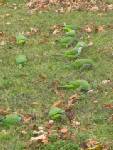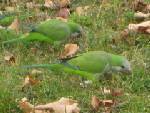A walk in the park, sans pigeons
I was in Chicago last weekend, staying in the Hyde Park area, along Lake Shore Drive. Lake Michigan is extraordinary, looking for all the world like the ocean, complete with whitecaps on a windy day and what appear to be ocean liners on the distant horizon.
All in all, a fine place to walk. But as I was moving along at my usual clip (four miles an hour, more or less) I saw the following startling sight:
“What’s that?” you ask.
Here, come a little closer:
They were hard to see at first, green on green. Not the sort of bird we’re used to in a climate as extreme in winter as Chicago or New England—or most of the United States, for that matter.
But there they were, neither a mirage nor a pink elephant-like hallucination: a whole flock of green parrots. Smallish ones, resembling large parakeets, and acting just as casual as robins or crows or that ubiquitous city bird, the pigeon.
What could they be doing there? I vowed to find out, and so when I returned to the apartment I relied on ever-trusty Google and discovered they are called monk parakeets or quaker parrots. What’s more, they’ve been around this country since the late 60s or early 70s, and live in colonies in fifteen states, including groups as far north as New York City, Chicago, Cincinnati, and coastal Rhode Island and Connecticut.
They seem to be rather hungry for learning, since I’ve noticed a certain predilection for universities—for example, they are so numerous near Brooklyn College that they are the unofficial mascot of the school newspaper, they are legion in the area around the city university of Madrid, and the Hyde Park colony is nuzzling up to the University of Chicago.
How did they get so far afield? Native to the temperate areas of Argentina and Brazil, they were exported and introduced as pets several decades ago. It is speculated that they were released either accidentally or intentionally many times and in many places, and their temperate origins have allowed them to survive in weather far from tropical.
They’re prettier than pigeons, and apparently cleaner, too. In Barcelona, they rival pigeons in numbers. And in the Greenwood Cemetery area of Brooklyn, they rival pigeons in other ways, as well:
While the [cemetery] grounds crew initially tried to destroy the unsightly nests at the entrance gate, they no longer do so, because the presence of the parrots has reduced the number of pigeons nesting within it. The management’s decision was based on a comparative chemical analysis of pigeon feces (which destroy brownstone structures) and Monk Parakeet feces (which have no ill effect). Oddly then, the Monk Parakeets are in effect preserving this historic structure.
This gentleman organizes tours (he calls them “safaris”) of the Brooklyn flocks; he also features a rather charming calendar devoted to the parrots of Brooklyn. And though something about the hardiness of the Chicago flock (they’re way cool!) and the street smarts of the Brooklyn parrots (they’re tough birds!) captures my heart, this ode to the San Francisco group (they’re so groovy!) sounds heartwarming.



A strong recommendation here for “The Wild Parrots of Telegraph Hill” that you link to at the last.
I’ve seen it and, although it can be a hard rental to find, it rewards persistence.
There are some references to them on forgotten-ny.com. Here’s one: http://www.forgotten-ny.com/STREET%20SCENES/parrots/parrots.html
Back around 1990 the Department of Agriculture announced plans to remove the Chicago flock because of the potential threat to crops. When it was pointed out that there are no crops growing in the city of Chicago, they dropped the idea.
Monk parakeets are simply the hardiest of the small parrots that are slowly colonizing North America through escapee pets that survive and breed. There are several different species, in different cities. They’re really just filling a niche- parrots are a very intelligent, adaptable group of birds, and there was no particular reason North America didn’t have many native parrot species other than biogeographical accident. (The Corvids fill the same niche in Europe and North America as parrots do in the southern hemispheres, so spreading on their own wasn’t easy with the competition.)
My mother lives in Phoenix. There’s a flock of wild lovebirds that like to sit in her palms and scream. That’s the only real drawback to the parrots- doves coo, parrots shriek.
Parrots are very much a vibrant and valued addition to our eco-ecomomy; Parrots do the jobs doves wont do.
Arrrrgh! With great gnashing of teeth, chorus’ of wails, kicking of slats, belting of moon calfs, I stand with dropped drawers and salute you. You’ve been through the wringer, Pinhead! When does this wee butchery of the remaining intact sections of the Constitution take place? Certain pagan rites must be adhered to. Gutting of toads, assaulting young saplings, licking of goat gonads, etc. If need be, vestal virgins will be sacrificed. Michelle, Ann and her Adam’s apple….. Nah, tainted meat, fer’ sure. Well, what ever it takes to get you through this ordeal, let me know. I’ll be spinning a Crow’s Nest stool in your honor.
Well, its not like “rock dove” aka “pigeon” is native either. At least not the common one we see in US cities.
So, have the Armadillos made it to the Great lakes yet? I know they are spreading North.
My grandmother still tells of the first time she saw one in Mississippi. That was when my Uncle was a boy(50s or 60s). He came running thru the yard saying an “anteater” or “ardvark” was after him.
I have heard second hand that my Grandfather on the other side of the family claimed the armadillos were brought by a logging company to East Texas from West Texas to kill Rattle snakes in the dense Piney Woods.
If that was really so, that spread them a bit further East- just in time to “chase” my Uncle in Mississippi years later.
I wonder if the proposed $1000 fine for feeding pigeons in NYC will apply to the parrots? If it only applies to the pigeons and not the parrots, surely the pigeons have grounds for a discrimination lawsuit.
Also, will the governor of NY issue these illegal parrots driver’s licenses and how long will it take to get Senator Clinton to give a straight answer when asked her view on that?
Wild Parrots of Telegraph Hill was a terrific movie.
Check out this article:
“A Retirement Villa for Chattering Birds by Eric Eckholm in The NYTimes on April 29, 2006:
CASCABEL, Ariz. –
The cherry-headed conure named Mingus and two other refugees from the feral flock made famous by the 2003 documentary “The Wild Parrots of Telegraph Hill” are also here. Physically handicapped, the three needed a new home after the squatter who tended them in San Francisco was forced from his house.
This story is a reminder how young modern ecosystems really are. Their age is less than 10000 years, a negligible time interval at geological or evolutionary scale. Transition from glaciation is far from complete, nature IS NOT at equilibrum as most of environment-obsessed crowd think. Spreading of animal species, even so mobile as birds, their resettlement and adaptation, often replacing of native species by intruders, is everyday reality. 11 000 years ago a huge ice sheet, two miles thick, covered all Canada and Great Lakes. Climate is changing, really fast, as it was always doing, for 2 million years at least.
Sergey, You said “…Transition from glaciation is far from complete, nature IS NOT at equilibrum as most of environment-obsessed crowd think..”
Perhaps it would be more accurate to say that new, temporary equilibriums are being formed- only to eventually be replaced by new equilibriums as new species move into an area and old ones die off.
As you implied, the environmentalist seem to believe in static equilibriums. The only “legitimate” equilibriums to them seem to be the ones in place in the 18th century or so.
Of course, my reference to “native” in an earlier comment unwittingly reflects that view.
Nature change on hierarchy of time scales, since it consists of a hierarchy of subsystems with highly different times of relaxation. No one of this temporary equilibra is truly static, they are quasy-stationary states, but in relation to more slow processes the more fast ones can be considered approaching eqilibra. Mathematically this can be taken as definition of self-organization, and on every time scale and for every subsystem there are stages of fast development and stages of slow development, called “stasis”, which lasts untill development of more slow process undermine this equilibrum.
In theory of self-organization this is called “principle of submission”: slow processes govern the dynamics of more fast ones. From this model it follows that development of the whole is a hierarhy of revolutions of different scale, intermingled with periods of stasis of different scale. These quasy-static states correspond to biological species or taxa of higher rank, or geological periods of different rank, from eras to ages, or climatic zones and different types of ecosystems.
Ah, the prolific quaker parrot. The rascals must surely be hearty species. I how they took over most of florida, round these parts anyway. I would certainly prefer looking at blue and gold macaw parrots. Quakers are just little noisy green things lol.